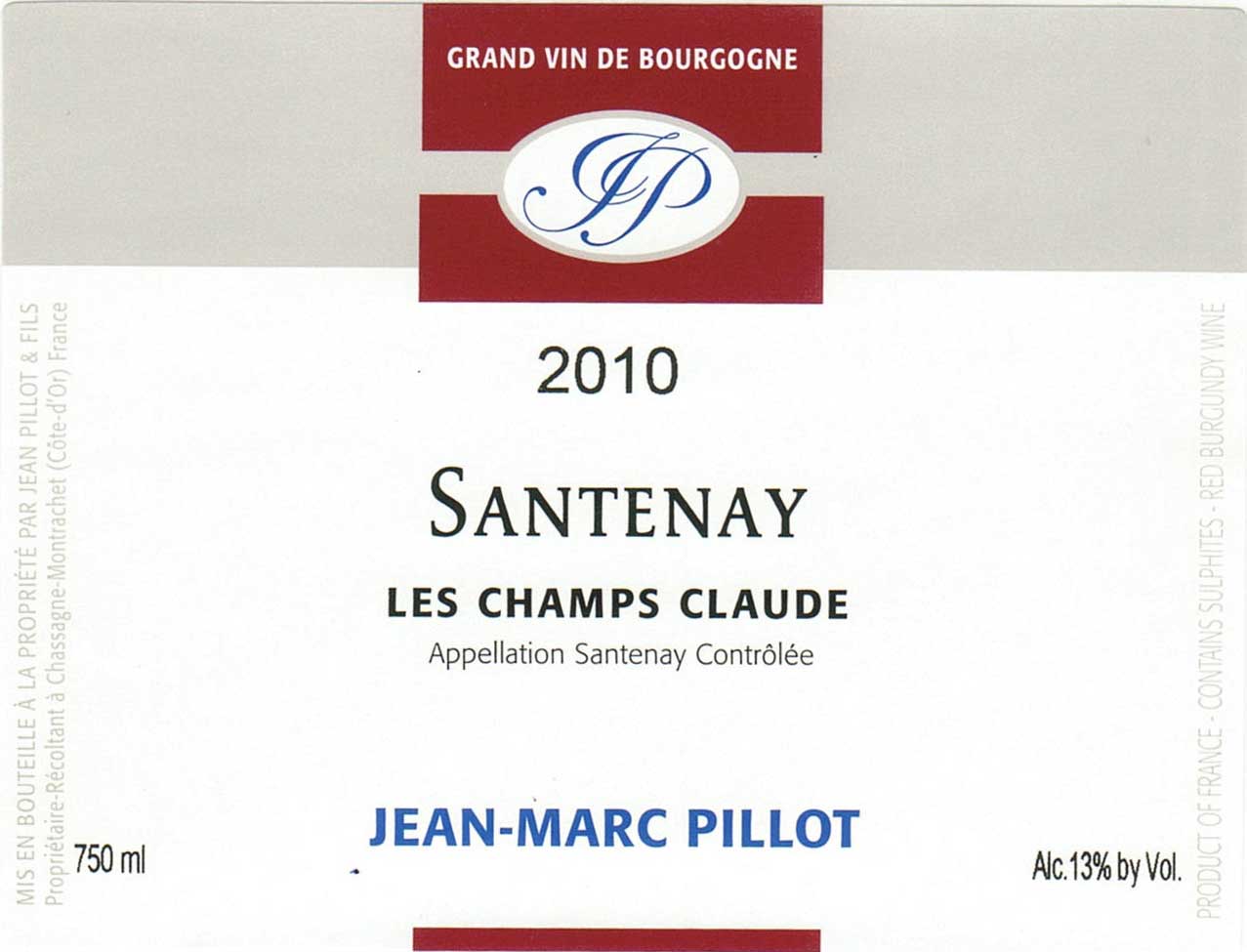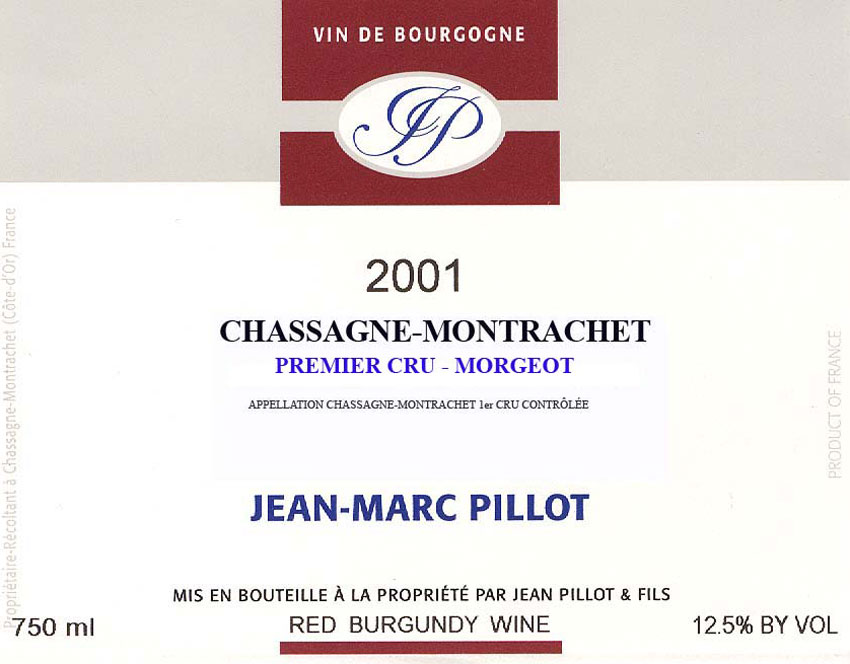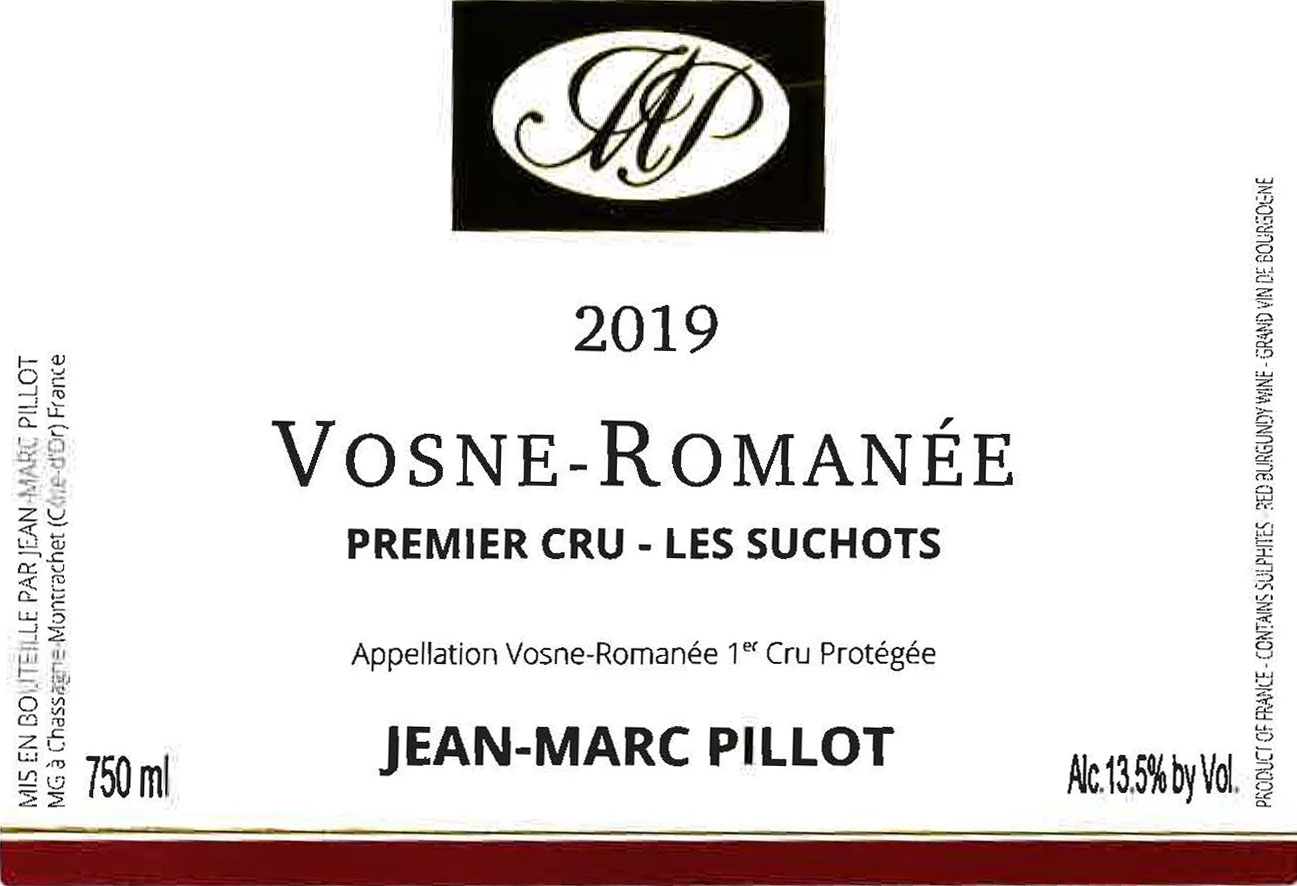
Jean-Marc Pillot
Wines
Chassagne-Montrachet
Bourgogne Aligoté
Jean-Marc owns a parcel of Aligoté in the village of Remigny planted in 2000. Vinified and aged entirely in stainless steel, this humble Bourgogne delights with brisk acidity and pure, tensile flavors of preserved lemon, sage, and musk melon. Nimble and easy-drinking, it nonetheless displays a modest degree of complexity for its variety, as well as a mouthwatering saline edge.
Bourgogne Blanc, “Le Haut des Champs”
From a parcel on the southeastern end of Chassagne-Montrachet, this wine now passes its élevage in stainless steel tank to preserve its freshness. It shares the broad shoulders and dense texture of the wines of Chassagne. Bottled twelve months after the harvest, this wine establishes the base-line for the generous, open style adopted by Jean-Marc Pillot for all of his wines. In years of normal production, we import 2,400 bottles for the US market.
Rully Blanc, “La Chaume”
Jean-Marc has been able to access fruit in this terrific appellation in the northern part of the Côte Chalonnaise from parcels owned by an old friend with whom he served in the military. La Chaume—from a large 41-hectare lieu-dit—is straightforward in its personality and thickly fruited but nonetheless offers attractive minerality and ample acid. This is given a proper 18-month élevage just like Jean-Marc’s pricier wines in the Côte de Beaune, and its modest 20% new oak is already well-integrated.
Rully Blanc, “Les Gaudoirs”
Les Gaudoirs is situated on a limestone plateau, and this cuvée comes from a parcel of 30-year-old Chardonnay planted in extremely stony, pebbly soils. It wears its 20% new oak very well (Jean-Marc is particularly deft in his balancing of wood and wine), and offers electric acidity and a salty, palate-staining minerality. It’s a crystalline and stylish wine very much in line with his Chassagne-Montrachet crus, and it offers tremendous value.
Montagny, “Les Bassets”
Pillot has a friend in the appellation of Montagny in the Côte Chalonnaise with some old vineyard holdings, the fruit of which he is happy to sell to Jean-Marc each year to help him round out his lineup with some accessibly priced wines of a different character. Les Bassets is a “split” vineyard, part of which is villages-classified and part of which is premier cru, and this parcel is just on the villages side. Vinified and aged entirely in stainless steel, this wine displays the racy acidity and chalky, almost Chablis-like character of Montagny at is best, but with a satisfying mid-palate richness.
Saint-Romain Blanc, “La Périère”
From this renowned poor-soiled vineyard in the high valley of Saint-Romain, Jean-Marc produces a wine of impressive power for the appellation—Saint-Romain as rendered by a master of Chassagne-Montrachet. Aged one-quarter in new barrels, this offers succulent orchard fruits on a relatively easygoing frame, with enough acidity to harmonize its elements but without pitching the wine toward shrillness. Vinified in stainless steel which emphasizes the earthy minerality of this appellation; we import around 50 cases annually.
Chassagne-Montrachet Blanc, “Les Masures”
Pillot owns half a hectare of Chardonnay in this well-positioned lieu-dit, which sits just below premier cru Champs-Gains on the slope. One third of his vines here were planted in 1950, one-third in 1990, and one-third in 2010. This is a classically rendered Chassagne-Montrachet, one which deftly balances rich, mouth-filling fruit with a powerful mineral thrust, and it carries a bright acidity in the finish which gives it length and breed.
Puligny-Montrachet, “Les Noyers Bret”
This wine is produced from the sole holdings of the Pillot family in the neighboring village of Puligny. Les Noyers Bret vineyard lies just downslope of Le Montrachet and its assorted hyphenations, and Jean-Marc owns a small parcel of vines between 50 and 100 years old here. Often among the most elegant of his wines (as befits the appellation), this is classical and precise, with truly outstanding length and a palate-coating intensity which swells toward the finish.
Rully Blanc 1er Cru, “Les Raclots”
Jean-Marc’s friend’s parcel in Les Raclots is 60 years old, planted in the appellation’s classic clay-limestone terrain. This cuvée offers a saline impression with good power and depth of fruit, and a sense of underlying richness that stops short of viscosity. Les Raclots more than holds its own against some of Jean-Marc’s more gras-oriented Chassagne-Montrachet 1er crus, and it will age terrifically.
Montagny 1er Cru, “Les Gouresses”
Jean-Marc purchases fruit from a friend who owns a parcel of 110-year-old vines in this well-situated premier cru, and from it he crafts a rich wine that also reflects the cut and stoniness typical of this appellation. Whereas a vigneron of Montagny might have left the wine in cuve, Pillot takes advantage of the concentration resulting from the old vines and ages it entirely in previously used barrels, bottling it after an 18-month élevage—the same length of aging as his more expensive offerings from the Côte de Beaune. Two barrels (fifty cases) find their way to the States annually.
Chassagne-Montrachet Blanc 1er Cru, “La Maltroie”
This tiny parcel of 0.16 hectares is a recent addition to the Pillot domaine. This lieu-dit is just south of the village and next to Les Champs-Gains. The vines were planted in 1951 and these old vines give a formidable level of concentration to this classic version of Chassagne.
Chassagne-Montrachet Blanc 1er Cru, “Les Champs-Gain”
The Champs-Gain vineyard is in the center of Chassagne, planted in about equal proportions to Chardonnay and Pinot Noir. Pillot has a one-quarter-hectare parcel of vines planted in 1977. The Champs-Gain here is a rich wine of classic Chassagne proportions, more generous and rugged than its neighbors to the north but without the complexity of the adjoining Caillerets.
Chassagne-Montrachet Blanc 1er Cru, “Les Macherelles”
Les Macherelles sits just to the south of the premier cru Les Chenevottes in the northern sector of Chassagne-Montrachet, immediately north of the village itself. Pillot’s 0.28 hectares of vines here were planted in the early 1950s, with a portion replanted in 1988, and this cuvée presents a remarkably stony nose, with focused, lean, strikingly refined flavors of lime zest and sea salt.
Chassagne-Montrachet Blanc 1er Cru, “Les Chenevottes”
This cuvée is from the northernmost holdings of the domaine in Chassagne as it fronts onto the border with Saint-Aubin and Puligny. It is here that Pillot reveals the more elegant side of Chassagne. A small holding (0.29 hectares, vines planted in 1950) that yields a wine that is generous and silky with more citrus notes than the cuvées from the southern edge of Chassagne. A barrel, or 300 bottles, is allocated for our use in the USA.
Chassagne-Montrachet Blanc 1er Cru, “Morgeot—Les Fairendes”
Among the crus, Morgeot is known for its broad-shouldered wines, often the most rich and unctuous of Chassagne. In this case, Jean-Marc’s vines are located within the most renowned sector of Morgeot known as Les Fairendes, a “vineyard within a vineyard.” Poorer topsoil here facilitates a more profound mineral expression than is found in its surrounding area. Pillot owns a quarter-hectare of vines planted in 1970, and he has purposefully begun harvesting it a bit earlier the past few vintages to counterbalance the intense richness this site tends to engender. Les Fairendes delivers an appealing combination of textural generosity and firm acidity that characterizes the overall house style here—richness with finesse that elevates it above its more rustic colleagues.
Chassagne-Montrachet Blanc 1er Cru, “Les Vergers”
Jean-Marc farms half a hectare of vines planted in the late 1940s in this premier cru, which sits immediately above Les Chenevottes and Les Macherelles on the slope, flanking them both. Always a standout in the lineup, it offers a nose of lemon-lime and quinine, and its minerality—while nonetheless formidable—melds sublimely into the fruit, contributing to an overall impression of seamless power.
Chassagne-Montrachet Blanc 1er Cru, “Les Baudines”
Les Baudines occupies a unique position within Chassagne-Montrachet, lying at the extreme south of the appellation (adjacent to Santenay) at the very highest point on the slope. Its position gives it slightly less exposure to the late day sun which provides this wine with raciness and fine breed rather than the more massive structure of the 1er Crus in the center section of the village. Jean-Marc owns a 0.15-hectare sliver of vines planted in 1975 and the wine he produces is always his most purely mineral-driven, presenting a cool, stony personality, moderating its sense of electricity with a subdued and elegant texture.
Chassagne-Montrachet Blanc 1er Cru, “Les Caillerets”
Among the most highly regarded of Chassagne’s premier crus, Les Caillerets is situated high on the slope, roughly equidistant between the village’s northern and southern borders. Pillot’s tiny holding here—a mere 0.18 hectares—yields what is often the most complex, full-spectrum premier cru in his cellar. This cuvée ratchets up the intensity to a level that exceeds its pedigree, and its finely chiseled, ultra-long finish suggests years of positive development.
Corton-Charlemagne Grand Cru
Jean-Marc Pillot typically makes two barrels a year from fruit purchased from his friend Blair Pethel of Domaine Dublère; Blair spent a year working alongside Jean-Marc and has generously allowed him access to a small part of his vineyard (a parcel formerly farmed by the Rollin family, our vignerons in Pernand-Vergelesses). Aromatically complex, honeyed, with wild herbs, mint and chamomile, the Corton-Charlemagne is massively scaled—both intensely mineral and nearly unctuous in its sappiness of fruit—and its 50% new oak is all but swallowed by the wine’s sheer concentration. We are fortunate to receive 5 cases of this a year for the US.
Chevalier-Montrachet Grand Cru
Given its higher (and thus slightly cooler) position on the slope, Chevalier-Montrachet sometimes rivals even Le Montrachet itself in quality. Certainly, Jean-Marc’s is the star of his cellar, and those fortunate enough to access the painfully minuscule quantities we are allocated will be thrilled with its multidimensionality and presence. Oily-textured and intoxicating in its enveloping saline aromatics, this completely possesses the palate, with a sizzling intensity and a finish well exceeding the minute mark.
Bourgogne Rouge, “Les Grandes Terres”
Jean-Marc owns a parcel Pinot Noir in the village of Remigny, just south of Chassagne-Montrachet, and produces an exemplary Bourgogne Rouge from his 65-year-old vines there. Given a proper 12-month élévage in used barrels, this Bourgogne is succulent and exuberant, with wild berry fruit, energetic tannins and an overall impression of vibrant silkiness.
Santenay Rouge, “Les Champs Claude”
Pillot owns a sizable 1.4-hectare parcel of Pinot Noir planted in 1970 in this Santenay lieu-dit, and his gentle extraction (100% whole clusters, employing only pump-overs) and no-new-oak élévage allow the friendly, juicy red fruit to take center stage over the rusticity typical of this appellation. The wine offers spice-drenched flavors of mentholated cherry, with a sense of rippling energy and mouthwatering acidity.
Chassagne-Montrachet Rouge, “Mes Vieilles Vignes”
Jean-Marc produces a remarkable red Chassagne-Montrachet from just over a hectare of Pinot Noir vines planted in 1960, and this old-vine cuvée is noteworthy in its complexity—particularly for a villages-level wine. Exceptionally structured, it nonetheless offers a purity of fruit, plus a gently earthy, brambly edge which speaks clearly of its Chassagne origin ... a village that should be more recognized for the high quality of its red wines, this being a prime example. 100% whole-cluster.
Chassagne-Montrachet Rouge 1er Cru, “Les Macherelles”
Pillot’s 0.37 hectare of Pinot Noir in the premier cru of Les Macherelles was planted in 1954, This cuvée presents a ripe, thick profile with a dark cast to the fruit; sappy and powerful, this possesses an almost chewy mouthfeel, with a dry and tightly mineral impression on the concentrated finish.
Chassagne-Montrachet Rouge 1er Cru, “Morgeot—Les Fairendes”
Pillot owns two-thirds of a hectare of Pinot Noir in Morgeot in the Fairendes climat, planted in 1967. This wine exhibits a ripe character, with a brisk, driving sense of kinetic energy on the palate. The fruit and mineral elements are nicely interwoven, with a smoothly textured finish. The Morgeot Rouge is a testament to the capacity of the village of Chassagne, and Jean-Marc in particular, to produce red wines of substantial character.
Chassagne-Montrachet Rouge 1er Cru, “Clos Saint-Jean”
Considered by many to be the greatest terroir for red wine in the entire appellation, Clos Saint-Jean sits high up on the slope, overlooking the village itself. Pillot owns just under half a hectare of staggeringly old Pinot Noir planted in 1910 in a parcel of 0.45 hectare size, producing what is unquestionably his grandest red from this site. There is a great sense of depth here and a layered character to the fruit which makes it feel at once nuanced and intense.
Vosne-Romanée 1er Cru, “Les Suchots”
Jean-Marc has access to a miniscule slice of this vaunted Vosne-Romanée premier cru, which is flanked by Échezeaux to the north and Richebourg and Romanée-Saint-Vivant to the south. He produces but one (new) barrel, on average, bearing a Burgundy which is oceanic in its depth and massive in its structure, and which beckons for a long rest in a cool cellar.




























